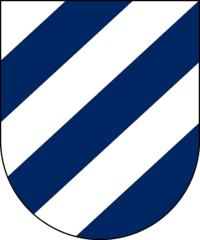Coat of arms of Ostry: Difference between revisions
No edit summary |
No edit summary |
||
| (2 intermediate revisions by the same user not shown) | |||
| Line 4: | Line 4: | ||
|alt = | |alt = | ||
|image_width = 200 | |image_width = 200 | ||
|armiger = [[Ostry| | |armiger = [[Ostry|Free State of Ostry]] | ||
|year_adopted = | |year_adopted = 1 April 1986 | ||
|until = | |until = | ||
|crest = | |crest = | ||
| Line 21: | Line 21: | ||
|notes = | |notes = | ||
}} | }} | ||
The '''{{wp|coat of arms}} of [[Ostry]]''' originate from around the 16th or 17th century, during | The '''{{wp|coat of arms}} of [[Ostry]]''' originate from around the 16th or 17th century, during Weranic control of the island, and were officially adopted as a symbol in 1986. The emblem first appeared in the ''Leitfaden für Symbole und Bräuche der nördlichen Länder der ostischen Königreiche'', first published in 1626. The coat of arms appear on many buildings dating to the early 19th century, around the same time that it became popular with Ostrins as a symbol of the island. | ||
==Description== | ==Description== | ||
According to the | According to the Regional Symbols Act of 1986, the coat of arms of the Free State of Ostry is "argent, three bend sinister azure". The design has gone through many interpretations since its initial appearance, with the current and most popular interpretation being that the white represents ice while blue represents the Perovo Sea. | ||
==See also== | ==See also== | ||
* [[Flag of Ostry]] | * [[Flag of Ostry]] | ||
* [[Here in the north]] | |||
{{Template:Ostrictopics}} | {{Template:Ostrictopics}} | ||
[[category:Ostry]][[category:Coat of Arms]] | [[category:Ostry]][[category:Coat of Arms]] | ||
Latest revision as of 07:11, 14 January 2020
| Coat of arms of Ostry | |
|---|---|
 | |
| Armiger | Free State of Ostry |
| Adopted | 1 April 1986 |
| Blazon | Argent, three bend sinister azure |
The coat of arms of Ostry originate from around the 16th or 17th century, during Weranic control of the island, and were officially adopted as a symbol in 1986. The emblem first appeared in the Leitfaden für Symbole und Bräuche der nördlichen Länder der ostischen Königreiche, first published in 1626. The coat of arms appear on many buildings dating to the early 19th century, around the same time that it became popular with Ostrins as a symbol of the island.
Description
According to the Regional Symbols Act of 1986, the coat of arms of the Free State of Ostry is "argent, three bend sinister azure". The design has gone through many interpretations since its initial appearance, with the current and most popular interpretation being that the white represents ice while blue represents the Perovo Sea.